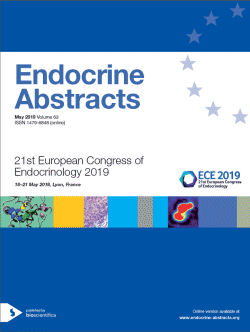
21st European Congress of Endocrinology
Lyon,
France
18 May 2019 - 21 May 2019
Guided Posters
Cushing's
ea0063gp153 | Cushing's | ECE2019
Evaluation of the corticotrophin-releasing-hormone test and the high dose dexamethasone suppression test in ACTH dependent Cushing’s syndrome: a 25-year prospective cohort study
Muller Dion R.P. , Gent-Houben Moniek C.F. , van Vessem-Timmermans Martine , Linthorst Gabor E. , Serlie Mireille J. , Siegelaar Sarah E. , Soeters Maarten R. , Hillebrand Jacquelien J. , Heijboer Annemieke C. , Fliers Eric , Bisschop Peter H. , Jan Stenvers Dirk
ea0063gp154 | Cushing's | ECE2019
Pathway enrichment analysis in functioning and silent corticotroph pituitary adenomas reveals mechanisms to explain their distinct clinical behaviour
Olarescu Nicoleta Cristina , Normann Kjersti Ringvoll , Sundaram Arvind YM , Oystese Kristin Astrid Berland , Eieland Alexander , Lekva Tove , Bollerslev Jens
ea0063gp155 | Cushing's | ECE2019
Endocrine immune-related adverse events following immune checkpoint inhibitors in patients with advanced melanoma: single-center retrospective analysis
Kassi Eva , Angelousi Anna , Asonitis Nikos , Petychaki Foteini , Diamantopoulos Panayiotis , Anastasopoulou Amalia , Benopoulou Olga , Gogas Helen
ea0063gp156 | Cushing's | ECE2019
Correlation between responsiveness to CRH stimulation test in Cushing’s disease patients and USP8 mutational status
Albani Adriana , Perez-Rivas Luis , Buchfelder Michael , Honegger Jurgen , Stalla Gunter , Zopp Stefanie , Reincke Martin , Theodoropoulou Marily
ea0063gp157 | Cushing's | ECE2019
DNA Methylation and fMRI responses in patients with Cushing’s syndrome in remission – suggestions of a functional link between hypercortisolism and neurocognitive dysfunction
Glad Camilla , Andersson-Assarsson Johanna , Stomby Andreas , Dahlqvist Per , Nyberg Lars , Bergthorsdottir Ragnhildur , Johannsson Gudmundur , Ragnarsson Oskar
ea0063gp158 | Cushing's | ECE2019
Cortisol and cortisone assays in hair by mass spectrometry for the diagnosis of Cushing’s syndrome
Brossaud Julie , De Angeli Delia , Corcuff Jean-Benoit , Charret Lea , Tabarin Antoine
ea0063gp159 | Cushing's | ECE2019
Skeletal muscle fatty infiltration in the thigh, as assessed by MRI T2-weighted and 3-point Dixon sequences, is associated with poor performance on muscle function testing in patients with Cushing’s syndrome in remission
Martel Luciana , Alonso Alicia , Bascunana Helena , Manera Jordi Diaz , Llauger Jaume , Nunez-Peralta Claudia , Biagetti Betina , Montesinos Paula , Webb Susan , Valassi Elena
ea0063gp160 | Cushing's | ECE2019
Brain 18F-fluorodeoxyglucose PET/CT in localization of MRI-negative ACTH-producing pituitary adenomas
Tsoy Uliana , Ryzhkova Daria , Cherebillo Vladislav , Ryzhkov Anton , Kuritsyna Natalia , Belousova Lidia , Dalmatova Anna , Grineva Elena
ea0063gp161 | Cushing's | ECE2019
Ubiquitin-specific protease 8 (USP8) potentiates glucocorticoid receptor activity in corticotroph tumour cells
Perez-Rivas Luis , Ciato Denis , Colon-Bolea Paula , Reincke Martin , Theodoropoulou Marily
ea0063gp162 | Cushing's | ECE2019
Pharmacokinetics of osilodrostat following single and multiple doses of osilodrostat in healthy subjects and patients with Cushing’s disease
Han Kevin , Tauchmanova Libuse , Atkinson Susan , Darstein Christelle , Zhang Xinrui , Combes Francois Pierre , Pedroncelli Alberto M
ea0063gp163 | Cushing's | ECE2019
Effects of a single dose of pasireotide on glucose metabolism in patients with Cushing’s disease and predictors of diabetes mellitus developement during treatment
Barbot Mattia , Regazzo Daniela , Zilio Marialuisa , Mondin Alessandro , Lizzul Laura , Pinelli Silvia , Scaroni Carla
ea0063gp164 | Cushing's | ECE2019
Assessment of bone marrow fat by single-voxel vertebral magnetic resonance spectroscopy in cushing’s syndrome with or without vertebral fractures
Ferrau Francesco , Giovinazzo Salvatore , Tessitore Agostino , Messina Erika , Vinci Sergio , Mazziotti Gherardo , Lania Andrea , Longo Marcello , Granata Francesca , Cannavo Salvatore



